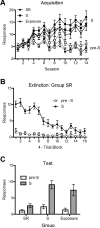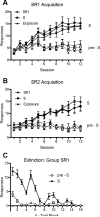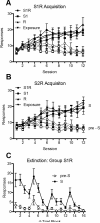Learning to inhibit the response during instrumental (operant) extinction
- PMID: 27379715
- PMCID: PMC4943680
- DOI: 10.1037/xan0000102
Learning to inhibit the response during instrumental (operant) extinction
Abstract
Five experiments tested implications of the idea that instrumental (operant) extinction involves learning to inhibit the learned response. All experiments used a discriminated operant procedure in which rats were reinforced for lever pressing or chain pulling in the presence of a discriminative stimulus (S), but not in its absence. In Experiment 1, extinction of the response (R) in the presence of S weakened responding in S, but equivalent nonreinforced exposure to S (without the opportunity to make R) did not. Experiment 2 replicated that result and found that extinction of R had no effect on a different R that had also been reinforced in the stimulus. In Experiments 3 and 4, rats first learned to perform several different stimulus and response combinations (S1R1, S2R1, S3R2, and S4R2). Extinction of a response in one stimulus (i.e., S1R1) transferred and weakened the same response, but not a different response, when it was tested in another stimulus (i.e., S2R1 but not S3R2). In Experiment 5, extinction still transferred between S1 and S2 when the stimuli set the occasion for R's association with different types of food pellets. The results confirm the importance of response inhibition in instrumental extinction: Nonreinforcement of the response in S causes the most effective suppression of responding, and response suppression is specific to the response but transfers and influences performance of the same response when it is occasioned by other stimuli. Theoretical and practical implications are discussed. (PsycINFO Database Record
(c) 2016 APA, all rights reserved).
Figures










Similar articles
-
Extinction of chained instrumental behaviors: Effects of procurement extinction on consumption responding.J Exp Psychol Anim Learn Cogn. 2015 Jul;41(3):232-46. doi: 10.1037/xan0000064. Epub 2015 Apr 27. J Exp Psychol Anim Learn Cogn. 2015. PMID: 25915751 Free PMC article.
-
Extinction of chained instrumental behaviors: Effects of consumption extinction on procurement responding.Learn Behav. 2016 Mar;44(1):85-96. doi: 10.3758/s13420-015-0193-y. Learn Behav. 2016. PMID: 26276367 Free PMC article.
-
Contextual control of chained instrumental behaviors.J Exp Psychol Anim Learn Cogn. 2016 Oct;42(4):401-414. doi: 10.1037/xan0000112. Epub 2016 Sep 5. J Exp Psychol Anim Learn Cogn. 2016. PMID: 27598060 Free PMC article.
-
Extinction and the associative structure of heterogeneous instrumental chains.Neurobiol Learn Mem. 2016 Sep;133:61-68. doi: 10.1016/j.nlm.2016.06.005. Epub 2016 Jun 11. Neurobiol Learn Mem. 2016. PMID: 27296700 Free PMC article. Review.
-
Occasion setting, inhibition, and the contextual control of extinction in Pavlovian and instrumental (operant) learning.Behav Processes. 2017 Apr;137:64-72. doi: 10.1016/j.beproc.2016.10.003. Epub 2016 Oct 6. Behav Processes. 2017. PMID: 27720958 Free PMC article. Review.
Cited by
-
Correction of response error versus stimulus error in the extinction of discriminated operant learning.J Exp Psychol Anim Learn Cogn. 2020 Oct;46(4):398-407. doi: 10.1037/xan0000267. Epub 2020 Jul 27. J Exp Psychol Anim Learn Cogn. 2020. PMID: 32718156 Free PMC article.
-
Effects of outcome devaluation on instrumental behaviors in a discriminated heterogeneous chain.J Exp Psychol Anim Learn Cogn. 2017 Jan;43(1):88-95. doi: 10.1037/xan0000119. J Exp Psychol Anim Learn Cogn. 2017. PMID: 28045296 Free PMC article.
-
Prediction and control of operant behavior: What you see is not all there is.Behav Anal (Wash D C). 2019 May;19(2):202-212. doi: 10.1037/bar0000108. Behav Anal (Wash D C). 2019. PMID: 31588411 Free PMC article.
-
Resurgence in humans: Reducing relapse by increasing generalization between treatment and testing.J Exp Psychol Anim Learn Cogn. 2019 Jul;45(3):338-349. doi: 10.1037/xan0000209. Epub 2019 Apr 29. J Exp Psychol Anim Learn Cogn. 2019. PMID: 31033312 Free PMC article.
-
Left Inferior Frontal Gyrus Participates in Mediating the Renewal Effect Irrespective of Context Salience.Front Behav Neurosci. 2020 Mar 27;14:43. doi: 10.3389/fnbeh.2020.00043. eCollection 2020. Front Behav Neurosci. 2020. PMID: 32292332 Free PMC article.
References
-
- Bouton ME. Context and ambiguity in the extinction of emotional learning: Implications for exposure therapy. Behaviour Research and Therapy. 1988;26:137–149. - PubMed
-
- Bouton ME. A contextual analysis of fear extinction. In: Martin PR, editor. Handbook of behavior therapy and psychological science: An integrative approach. Pergamon Press, Inc.; Elmsford, NY: 1991. pp. 435–453.
-
- Bouton ME. Context, ambiguity, and unlearning: Sources of relapse after behavioral extinction. Biological Psychiatry. 2002;52:976–986. - PubMed
MeSH terms
Grants and funding
LinkOut - more resources
Full Text Sources
Other Literature Sources

